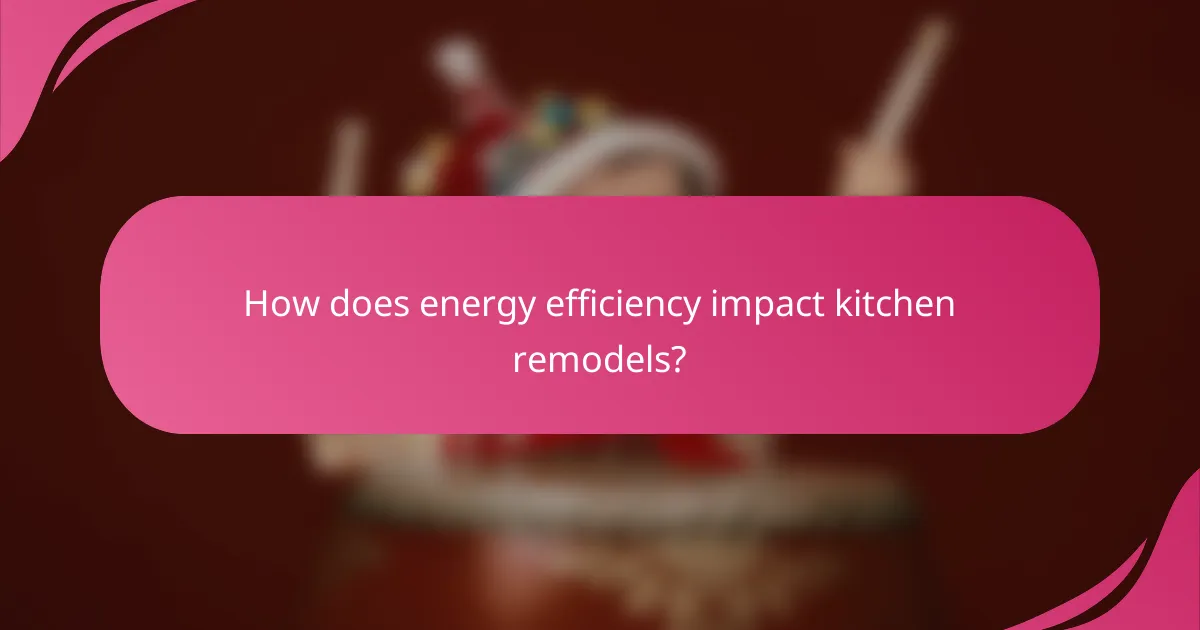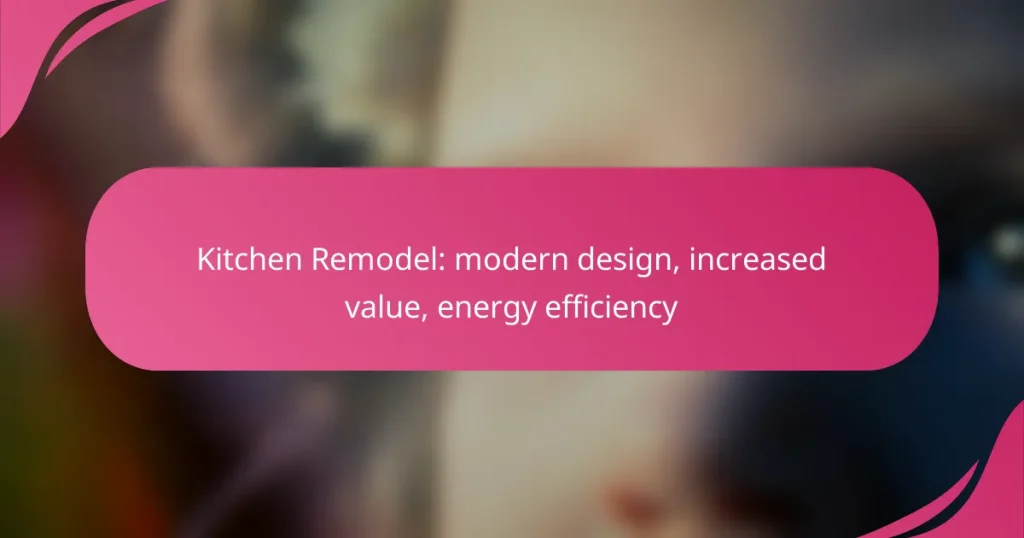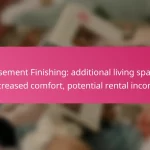A kitchen remodel is a strategic investment that can elevate your home’s value by modernizing the space and enhancing its functionality. By embracing contemporary design trends, such as open layouts and energy-efficient features, homeowners can create a more appealing and sustainable kitchen that attracts potential buyers and reduces utility costs.

How can a kitchen remodel increase home value in Canada?
A kitchen remodel can significantly enhance home value in Canada by modernizing the space and improving functionality. Homebuyers often prioritize updated kitchens, making them a key factor in real estate appraisals and sales.
Return on investment statistics
On average, homeowners in Canada can expect to recoup about 70% to 80% of their kitchen remodel costs when selling their home. This percentage can vary based on the extent of the renovation and the local market conditions.
Minor renovations, such as updating fixtures and cabinetry, typically yield a higher return compared to extensive remodels. Homeowners should consider focusing on cost-effective updates that appeal to a broad range of buyers.
Key features that boost value
Modern appliances, energy-efficient fixtures, and open-concept layouts are among the key features that can boost a kitchen’s value. High-quality materials, such as granite countertops and hardwood flooring, also attract buyers.
Incorporating smart technology, like programmable thermostats and energy-efficient lighting, can further enhance appeal. These features not only improve usability but also signal to buyers that the home is up-to-date with current trends.
Market trends in Canadian real estate
The Canadian real estate market is increasingly favoring homes with modern, functional kitchens. As more buyers seek energy-efficient and sustainable options, kitchens that reflect these values tend to sell faster and at higher prices.
Current trends show a growing interest in open layouts that integrate the kitchen with living spaces. This shift highlights the importance of creating a welcoming environment that facilitates both cooking and socializing.

What modern design trends are popular for kitchen remodels?
Modern kitchen remodels often emphasize open layouts, smart technology, and eco-friendly materials. These trends not only enhance aesthetics but also improve functionality and energy efficiency, making kitchens more enjoyable and valuable.
Open concept layouts
Open concept layouts are a hallmark of modern kitchen design, creating a seamless flow between the kitchen, dining, and living areas. This design encourages social interaction and makes spaces feel larger and more inviting.
When considering an open layout, think about removing non-load-bearing walls to enhance accessibility. Ensure that the kitchen island or peninsula serves as a functional space for cooking and entertaining, ideally with seating options.
Smart kitchen technology
Smart kitchen technology includes devices that enhance convenience and efficiency, such as smart refrigerators, ovens, and lighting systems. These appliances can be controlled remotely, allowing for better energy management and improved cooking experiences.
Investing in smart technology can lead to significant energy savings and increased home value. Look for devices that integrate with home automation systems and consider features like energy monitoring to maximize efficiency.
Eco-friendly materials
Using eco-friendly materials in kitchen remodels not only supports sustainability but also contributes to healthier indoor environments. Options include recycled countertops, sustainably sourced wood cabinets, and low-VOC paints.
When selecting materials, prioritize those with certifications for sustainability, such as FSC for wood products or Energy Star for appliances. This approach not only reduces environmental impact but can also appeal to eco-conscious buyers, enhancing your home’s marketability.

How does energy efficiency impact kitchen remodels?
Energy efficiency significantly enhances kitchen remodels by reducing utility costs and increasing overall home value. Incorporating energy-efficient features can lead to long-term savings and a more sustainable living environment.
Energy-efficient appliances
Choosing energy-efficient appliances is crucial for a successful kitchen remodel. Look for appliances with the ENERGY STAR label, which indicates they meet strict efficiency guidelines set by the U.S. Environmental Protection Agency. These appliances can use 10-50% less energy compared to standard models, translating into lower electricity bills.
When selecting appliances, consider the size and capacity that best fits your cooking habits. For instance, a larger refrigerator may be necessary for a family, while a compact model could suffice for singles or couples. Additionally, opting for induction cooktops can reduce cooking time and energy consumption.
Insulation and windows
Proper insulation and energy-efficient windows play a vital role in maintaining a comfortable kitchen environment. Insulating walls, ceilings, and floors can help minimize heat loss in winter and keep the space cool in summer, reducing the need for heating and cooling systems.
When replacing windows, consider double or triple-pane glass, which can significantly reduce heat transfer. Look for windows with a low U-factor, indicating better insulation properties. This investment can lead to energy savings and improved comfort throughout the year.
Lighting solutions
Lighting solutions in a kitchen remodel can greatly impact energy efficiency. Switching to LED bulbs can reduce energy consumption by up to 75% compared to traditional incandescent bulbs while providing better illumination. LEDs also have a longer lifespan, which means less frequent replacements.
Incorporate natural light through skylights or larger windows to reduce reliance on artificial lighting during the day. Additionally, consider using dimmers and smart lighting systems to control energy usage based on your needs, allowing for a more adaptable and efficient kitchen environment.

What are the costs associated with kitchen remodeling in Canada?
The costs of kitchen remodeling in Canada can vary widely based on the scope of the project, materials used, and labor costs. Homeowners can expect to spend anywhere from CAD 15,000 to CAD 50,000 or more, depending on the complexity and quality of the remodel.
Average cost breakdown
A typical kitchen remodel in Canada often includes several key components, each contributing to the overall cost. On average, cabinetry can account for 30-40% of the budget, while countertops may take up 10-15%. Additional expenses include appliances (15-20%), flooring (5-10%), and labor costs (20-30%).
For example, a mid-range kitchen remodel might cost around CAD 25,000, with approximately CAD 10,000 allocated for cabinetry, CAD 4,000 for countertops, and CAD 5,000 for appliances. These figures can fluctuate based on design choices and regional pricing variations.
Factors affecting costs
Several factors can influence the costs of a kitchen remodel in Canada. The size of the kitchen is a primary consideration; larger spaces typically require more materials and labor. Additionally, the choice of materials—such as high-end versus budget-friendly options—can significantly impact the overall expense.
Labor costs can also vary by region, with urban areas often charging more than rural locations. Other considerations include the complexity of the design, any structural changes needed, and whether plumbing or electrical systems require upgrades.
Financing options available
Homeowners looking to finance their kitchen remodel have several options. Personal loans, home equity lines of credit (HELOC), and credit cards are common methods for funding renovations. Each option has its pros and cons, such as interest rates and repayment terms, which should be carefully evaluated.
Additionally, some homeowners may qualify for government grants or incentives aimed at improving energy efficiency in their kitchens. Researching local programs can provide financial assistance and help offset some remodeling costs.

What are the steps to plan a successful kitchen remodel?
Planning a successful kitchen remodel involves several key steps, including defining your goals, setting a budget, and creating a timeline. By following a structured approach, you can ensure that your remodel enhances both the functionality and aesthetics of your kitchen.
Design consultation process
The design consultation process is crucial for aligning your vision with practical considerations. Start by gathering inspiration from magazines, websites, or showrooms to clarify your style preferences. Schedule consultations with designers who can provide insights into layout, materials, and current trends.
During consultations, discuss your needs, such as storage solutions and energy-efficient appliances. A good designer will help you balance aesthetics with functionality, ensuring that the final design meets your lifestyle requirements.
Choosing a contractor
Selecting the right contractor is essential for a smooth remodeling process. Look for licensed professionals with experience in kitchen renovations, and check their references and past work. It’s wise to obtain multiple quotes to compare pricing and services offered.
Ensure that the contractor understands your design vision and can work within your budget. Clear communication about timelines, materials, and expectations will help prevent misunderstandings throughout the project.
Timeline for completion
Establishing a realistic timeline for your kitchen remodel is vital for managing expectations. A typical kitchen renovation can take anywhere from a few weeks to several months, depending on the scope of work and the complexity of the design.
Break down the project into phases, such as demolition, construction, and finishing touches. Regular check-ins with your contractor can help keep the project on track and allow for adjustments if unexpected delays arise.


